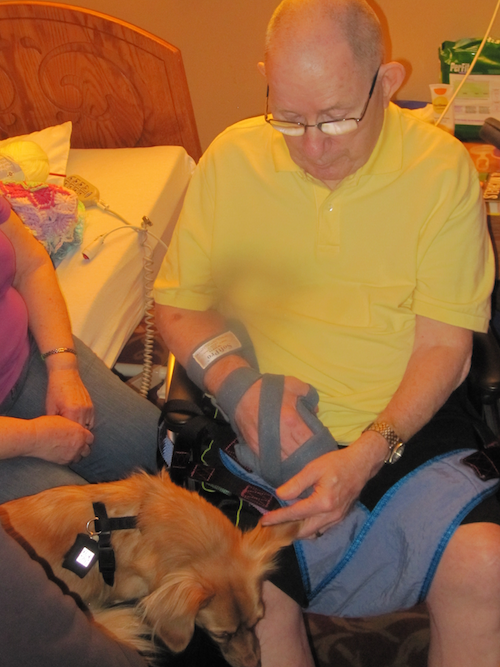
Connecting Within Through Animal Visitation
It’s Wednesday. A woman and a small dog walk through the front door of a dementia care community and greet the staff members clustered around the reception desk. After a brief chat with the activities director the pair walks toward the recreation room and greets one of the residents.
The resident, a woman with advanced Alzheimer’s disease, doesn’t say anything. She rarely speaks and when she does, little of what she says makes sense to anyone but herself. Gradually, the woman notices the presence of the visitors. Ever so slowly, she reaches out her hand to touch the dog. The hint of a smile touches her face.
On another day, a man is seated in a wheelchair in a physical therapy clinic. The man should be doing special exercises to help him be more mobile following a stroke. He is apathetic and reluctant to try any movement – until he sees the Animal-Assisted Therapy team – his special physical therapy partners.
Animal-Assisted Therapy & Animal-Assisted Activities:
Both of these scenarios are familiar to the men, women, and their therapy animals who visit or work in care centers, schools, hospitals and other care-providing centers. They provide special services to their clients as part of Animal-Assisted Therapy (AAT) or Animal-Assisted Activities (AAA) programs. Their animal partners are usually, but not always, dogs.
AAA is a less formal program. The human visitor takes his or her therapy animal to a health care setting. Together they visit with the patients, residents, groups and individuals who wish to spend a few minutes being gently greeted and comforted by the animals.
AAT provides similarly important services as AAA but with a different structure. AAT incorporates animals into a treatment program for individuals and small groups whether the patients are in an educational or health care setting. The AAT programs are focused on achieving therapy goals and animals are an integral part of that goal-achieving process.
Elderly people particularly benefit from these visits. Reports and observations in addition to formal studies have noted benefits of animal/human interaction programs, including:
Emotional and social support
Non-judgmental comforting
Trust – animals never betray trust or reveal secrets shared with them
Feeling of acceptance
Reconnection, especially in those individuals who have withdrawn into themselves
The physical and mental health benefits experienced by people living in assisted care, hospital and hospice settings is being documented in ongoing studies. Among the benefits noted in many studies are:
Lowered blood pressure
Reduced anxiety and agitation (particularly among dementia patients)
Reduced depression
Feeling of acceptance
Increased physical activity
Improved eating following the dog’s visit
Animals often help people connect with happy memories of earlier family pets. That reconnection is both tactile and emotional. Animal visitors seem to draw awareness from dementia patients normally unresponsive to other stimuli.
Perhaps the most touching pet visitations are made by pet therapists that seem to focus specifically on the individuals about to make their transitions. It is possible these special animals may be “gifting” patients who are passing with a final gentle caress and permission to finish their journeys in peace.
Therapy Animals:
Animals that are part of specific AAA or AAT programs should be mature enough to be stable, gentle, quiet and able to promptly respond to their handler’s commands. In addition, AAA/AAT animals are expected or required to be:
Regularly vaccinated
Certified as having successfully completed good behavior training (such as the Canine Good Citizen certification)
Registered or certified through a therapy animal program
Free of parasites such as fleas, ticks, worms, etc.
Regularly bathed and groomed prior to visits
The Animal Healers:
Are animals healers? There may never be a definitive, scientifically determined answer to the question.
For many people, there seems to be no doubt that animals provide comfort in times of mental and physical challenges and even transition. Animals enable humans to experience the joy of safely connecting with another living being, revitalize the tactile response function as skin connects with fur, calm the spirit when gazing into gentle eyes and to know the comfort that whispered secrets will be kept.